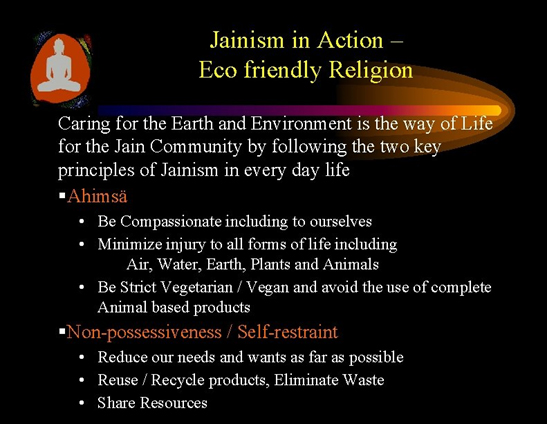How do practices that are derived using these vows become eco friendly?
Through the partial vow of non-violence (Ahinsa), a promise is made to never intentionally harm any living being. Ideally violence of any form is prohibited, but complete abstinence from non-violence is impossible for a lay person as he cannot escape violence encountered while performing activities that are necessary for life to go on. Thus, limiting violence is the goal and there is no limit on minimization, one should minimize wherever possible and to one’s capacity.
For example, food is a basic necessity for any human being. Here in a situation where violence is unavoidable for self sustenance, it is logically determined to consume only one sensed being which can sense lesser pain being at lower stages of biological development. This is the reason that the prescribed Jaina diet is a plant based vegetarian diet. Most researchers agree that a cutting down on meat or no-meat diet will surely help one to reduce the carbon footprint and be more environment friendly, because of the huge number of resources required to produce meat, deforestation to feed cattle and pollution caused due to by products, which is significantly more than in plants.
Similarly, Water and electricity need to be used cautiously too as reducing the energy and water usage reduces the demand for fossil fuels and, in turn, can lower the levels of carbon dioxide in the atmosphere. Jains abide to both direct and indirect form of non-violence as well as principle of non-possession through practice of conservation of water
Jains are also asked to select travel options with utmost care in order to protect lower forms of life as far as possible to avoid committing violence. One should not fly if driving is possible and should not drive if walking is possible. From an environmental perspective, reducing travel distances reduces fuel consumption and in turn reduces greenhouse gas emission.
Partial vow of limited possession (Aparigrha) brings check on human greed and ambition. This vow requires one to limit necessities of life. Practitioner of this vow promises himself that he will never gather more than some fixed amount of material possessions like house, land, gold, clothes, vehicles, servants, etc. It is the best way to tackle consumerism and reduce unnecessary consumption. As said by Mahatma Gandhi, “Earth provides enough to satisfy every man’s needs but not one’s greed”. The modern principle of reduce, reuse, and recycle is a perfect application of the principle of non-possession.
The Virtue fostering vows are special vows that put limits on one’s travel, food, and unnecessary activities. The vow to limit travel is the promise to go only certain distances in certain directions and fix the boundaries of movement. Vow to limit food and other material enjoyment is to promise to limit quantities of things we consume and use. Vow to limit activities puts restrictions on professions, businesses and industries that involve excessive violence and ecological imbalance to earn livelihood. Cutting forest is not allowed. Professions like mining, making charcoal, business of Ivory, business that involves fur and hair, drying lakes and ponds, burning forests, etc are prohibited.
Usually, most of an individual’s carbon footprint will come from food, housing, and transportation. All above discussed limitations and prohibitions will help one to reduce the carbon footprint if one chooses to practice them in day-to-day life.
Another important point that must be kept in mind is that the Jaina principles are the guiding principles which help in deriving the practices to be followed. It is very much possible for new practices to evolve and even older ones to be obsolete on account of changing time and location. These principles need to be pondered over again and again for checking its application in current times. For example, looking at immense violence in factory farms, certain Jainas now believe that consumption of milk and milk products should also be prohibited to abide by the principle of non-violence.
Conclusion
To sum up, many Jaina practices are eco-friendly and practicing the same would help one to be in harmony with nature along with following the path prescribed by Lord Mahavir. People sometimes argue that the objective or intent behind these practices is not the true concern for the environment, but it’s a somewhat selfish motive of moksha or self-realization. But this argument does not have enough grounding when one ponders over and understands the deep meaning of Ahinsa and its application as well as how everything in this world is interconnected as explained in Tattvartha Sutra. So, with this greater awareness let’s all work together to be in harmony with nature and be the true Jains.






Jaina eco friendly principles explained very nicely.
Can you be more specific about the content of your article? After reading it, I still have some doubts. Hope you can help me.